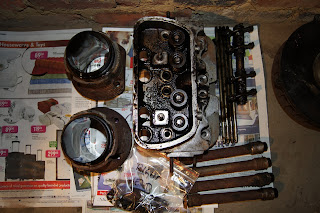We decided to install a new ceiling even the original still was in a relatively good condition. There was however some dirty spots every here and there that could not be removed. The original padding was left untouched. The overall work took us 8 hours to finish and it is definitely handy to have two persons involved in the process. There is lots of useful information available online to help one with the task, even installation videos on Youtube.
Original ceiling, detached from the window frames.
The padding unfolded from underneath the vinyl ceiling. It was in good condition so it was left untouched.
We started by assembling the rods and fixing the front at its place. The direction was from front to back, one section at the time. The main concern was to avoid wrinkling and hanging of the material. The heat gun was used to warm up the vinyl; this enabled to properly tighten the material when fixing it. Adhesive glue was used to fix the ceiling onto the window frames.
Interior after the installation.
Interior after the installation.

















































